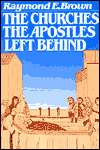
The chief apostles of Christ died in the mid-60s of the first century - at least those of whom we have solid knowledge: Peter, Paul, and James 'the brother of the Lord.' This means that most of the New Testament works were addressed to churches that no longer had living apostolic guides. What made these churches "tick"? How did they survive?
This book is a study of seven very different churches in the New Testament period after the death of the apostles. These churches had quite diverse emphases in their community life, as detectable from the biblical writings addressed to them. Three of the churches are in the heritage of Paul, one in the heritage of Peter, two in the heritage of the Beloved Disciple (Johannine writings), and the last is the church addressed by the First Gospel (Matthew).
RAYMOND E. BROWN, until his death in 1998, held a distinguished biblical professorship at Union Theological Seminary in New York City. Using his scriptural knowlege of the New Testament and his ecumenical knowledge of church situations today, he has written here what may be his most pastoral book. Catholic or Protestant, you will find your church's life and problems anticipated in Brown's analysis of the strengths and weaknesses of various New Testament church situations.